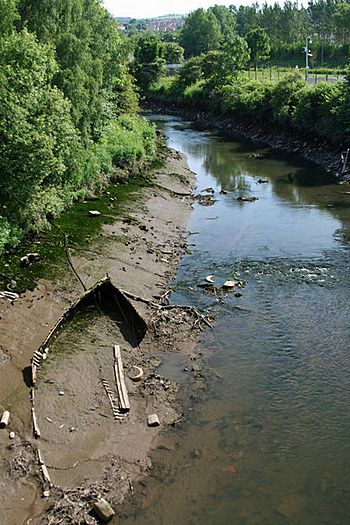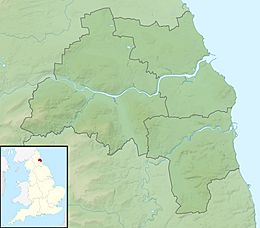River Team facts for kids
Quick facts for kids River Team |
|
|---|---|

River Team near Gateshead
|
|
|
Location of mouth within Tyne and Wear
|
|
| Country | United Kingdom |
| Country within the UK | England |
| Counties | Tyne and Wear, County Durham |
| Towns | Gateshead |
| Physical characteristics | |
| River mouth | Confluence with the River Tyne, Dunston, Tyne and Wear 54°57′28″N 1°38′14″W / 54.957709°N 1.637177°W |
The River Team is a small river that flows into the bigger River Tyne in Gateshead, England. It's an important part of the local area's history and environment.
Contents
What's in a Name?
The name Team might come from an old language called Brittonic. It could mean something like "melting" or "dissolving." Some people also think it might be linked to ancient words meaning "dark" or "cut."
Where Does the River Team Flow?
The River Team starts near Annfield Plain, where it's first known as Kyo Burn. It then changes its name to Causey Burn as it flows under the famous Causey Arch.
Next, it flows past Beamish Museum in County Durham, where it's called Beamish Burn. After that, it crosses into Gateshead and goes through Lamesley.
The river continues into the Team Valley. Here, it flows through a hidden tunnel, called a culvert, under the A1 road. It stays in a covered culvert through the Team Valley Trading Estate before coming back to the surface.
Finally, the River Team flows through the area where the 1990 National Garden Festival was held. It then joins the River Tyne in Dunston. This area is even named Teams, after the river!
Keeping the River Clean
For a long time, the River Team was known as one of the most polluted rivers nearby. This was because of waste from sewage works near Lamesley and factories in the Team Valley. Some local people even called it "The Gut."
However, a lot of work has been done to clean up the river. Now, it's much cleaner than it used to be.
How River Health is Measured
Experts check the water quality of rivers in England. They give each river an overall "ecological status" – like a health report for the river. This status can be high, good, moderate, poor, or bad.
To figure this out, they look at different things:
- Biological status: This checks the types and numbers of living things in the river, like tiny water creatures (invertebrates), plants, and fish.
- Chemical status: This checks for different chemicals in the water and compares them to safe levels. This status is either "good" or "fail."
Here's how the River Team's water quality was in 2019:
| Section | Ecological Status |
Chemical Status |
Overall Status |
Length | Catchment | Channel |
|---|---|---|---|---|---|---|
| Team from Source to Tyne | Moderate | Fail | Moderate | 23.158 km (14.390 mi) | 85.064 km2 (32.843 sq mi) | Heavily modified |
How the River Changed Over Time
Before the last Ice Age, the lower part of the River Team was actually part of a much bigger river, the River Wear. The River Wear and the River Tyne used to join up and flow to the coast from Dunston.
But when the ice age ended, the ice changed the path of the River Wear. It was forced to flow to the coast at Sunderland instead. The smaller River Team then started flowing along the old path of the River Wear towards the River Tyne.


